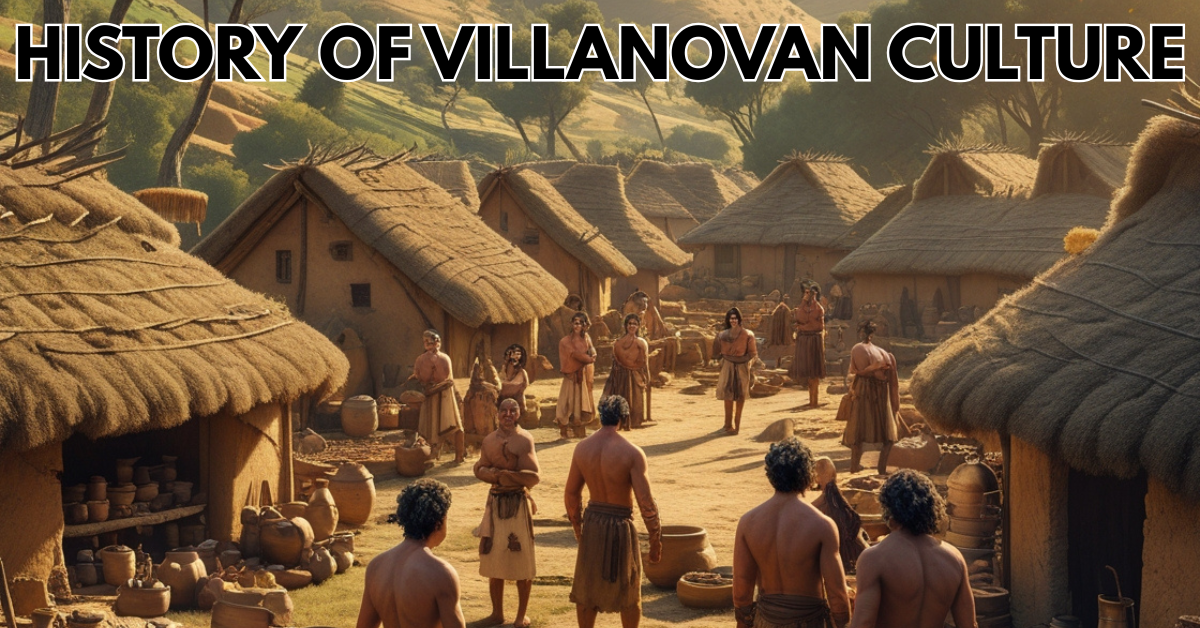Villanovan Culture
The Villanovan culture was an early Iron Age civilization in Italy, named after the village of Villanova near Bologna, where its distinctive cemeteries were first discovered in 1853. Emerging around the 10th or 9th century BCE, the Villanovans descended from the Urnfield cultures of eastern Europe, known for their practice of cremation.
Their burial customs involved placing cremated remains in pottery ossuaries, typically biconical in shape, and covering them with a bowl. Some urns featured lids modeled after helmets—either the knobbed bell helmets of central Europe or crested ones from northern Europe. In Tuscany, Villanovans also used terra-cotta hut urns, miniature models of their pole-framed, wattle-and-daub dwellings—similar in style to urns found in northern Europe.
Villanovans had access to rich copper and iron deposits in Tuscany, which made them skilled metalworkers. Around the 8th century BCE, Greek artistic influence reached the Villanovans, leading to stylistic changes and a shift toward inhumation (burial of bodies) rather than cremation, mirroring trends in Greece.
By the early 7th century BCE, an Orientalizing civilization—likely introduced by the Etruscans—began to overlay Villanovan culture in Tuscany. However, in the Po Valley to the north, the Villanovans maintained their geometric art style until the late 6th century BCE, when Etruscan expansion eventually absorbed and replaced them.
Bronze Age Overview
The Bronze Age was the third major period in the evolution of human material culture, following the Paleolithic (Old Stone Age) and Neolithic (New Stone Age). This era saw the first widespread use of metal—initially copper, then bronze (an alloy of copper and tin).
The start of the Bronze Age varied by region. It began before 3000 BCE in Greece and China, but only around 1900 BCE in Britain. An early phase, often called the Chalcolithic or Copper-Stone Age, featured tools made of pure copper used alongside stone.
Copper use was documented as early as 6500 BCE in eastern Anatolia, spreading through the Mediterranean and into Europe. True bronze tools and weapons became common by the 2nd millennium BCE, thanks in part to tin sources like Cornwall in England. This era saw major advancements, including urbanization, the invention of the wheel, and the ox-drawn plow.
By 1000 BCE, the rise of ironworking signaled the transition to the Iron Age, ending the dominance of bronze.
Ancient Rome: Origins and Legacy
Ancient Rome was one of history’s most powerful imperial civilizations, growing from a small town on the Tiber River to a vast empire stretching across Europe, Asia, and North Africa. Rome’s early period—beginning with its traditional founding in 753 BCE—included the regal period, followed by the Republic (509 BCE) and eventually the Empire (27 BCE).
Unlike the Greek city-states, Rome had a more inclusive approach to governance. It gradually extended citizenship to conquered peoples, integrating them into its political and social systems. This inclusivity helped Rome expand and maintain its vast empire.
Roman influence remains foundational in Western civilization. The Latin language evolved into the Romance languages (Italian, French, Spanish, Portuguese, Romanian). The alphabet, calendar, legal system, and architecture of the West all bear the imprint of Roman culture.
Sources on Early Roman History
The regal period (753–509 BCE) and early Republic (509–280 BCE) are poorly documented, as Roman historical writing didn’t begin until centuries later. The first Roman historian, Quintus Fabius Pictor, wrote during the Second Punic War (218–201 BCE). Before that, Roman history was preserved mainly through oral tradition, religious records, and legal documents.
Early histories, such as those written by Livy, often blended fact with myth and folklore, drawing from both Roman and Greek traditions. The annalistic tradition of Roman historical writing aimed to present a year-by-year account of events, though much of it was colored by later political ideologies and rhetorical embellishment.
Livy’s account of early Rome—written during the reign of Augustus—relied heavily on these earlier sources and often reflects more about the late Republic’s concerns than about early Roman realities. Thus, modern historians must carefully sift through layers of tradition, invention, and interpretation to understand Rome’s formative centuries.
